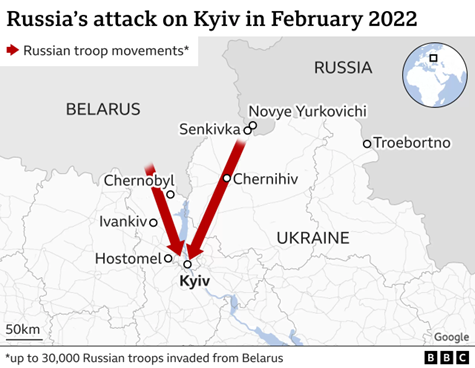The Daily Escape:

Escalante NM, UT – October 2023 drone photo by Brete Thomas
Last night, President Biden said that the world is at an inflection point. The next stage of the Israel/Hamas conflict is beginning. From the WaPo:
“Israeli troops are massing around the Gaza Strip, poised for a ground invasion that could involve heavy urban combat in the densely populated territory. The buildup of force comes after attackers from the militant group Hamas, which controls the enclave, crossed into southern Israel, killing at least 1,400 people and taking more than 200 hostages.”has and will be written about the next stage concerns what is a “justifiable” retaliatory action by the Israelis. The Israel Defense Forces (IDF) have already pummeled Gaza with airstrikes, killing more than 3,000 Palestinians, according to the Palestinians.
Much of what the Israelis seemingly are planning on doing is entirely justifiable, so long as there is an overarching strategy behind it. What we do know is that Israel has vowed to “destroy” Hamas. That means an extensive ground war in Gaza.
Without a strategy for what happens after Hamas is rooted out, this will look more like a reprisal strike whenever the IDF leaves Gaza. And there’s absolutely a moral problem with reprisals that kill many civilians. The law (and custom) of war would say there isn’t a problem with reprisals in which you’re killing only Hamas. But if the IDF happens to kill a lot of civilians along the way, even if it is lawful, the world would want to see that Israel has a long-term strategic objective that justifies those actions.
The WaPo quotes Raphael Cohen, a senior political scientist at Rand Corp: (parenthesis by Wrongo)
“Basically what the Israelis are aiming for is complete regime change in Gaza, which is a notable break from past campaigns….If you want to root out Hamas, it’s going to last a lot more than 50 days like Protective Edge, (referring to the IDF’s 2014 Gaza operation)”.
The general rule is that armies are not allowed to target civilians, but you are allowed to target combatants or belligerents of the other side. Urban warfare has always shown that civilians and belligerents are not necessarily distinct from one another. Often the fighters aren’t wearing uniforms.
The US military saw this in Mosul and Raqqa while fighting ISIS. The bad guys are basing themselves in the same buildings that civilians live in. That means the military has to weigh factors like the necessity of the military strike, and whether the expected civilian harm is proportionate to the expected military gain.
Let’s game out how it might look on the ground in Gaza. Remember, that Hamas is thought to have a membership of between 20,000 and 25,000.
First, Israel will have control of the airspace over Gaza. That will make rooftops a very poor place for Hamas sniper and rocket positions.
Second, Israel has amassed artillery and tanks to provide massive firepower. This is an advantage to IDF troops since overwhelming firepower will reduce risk to its soldiers. But it is a huge disadvantage to civilian populations, and it’s incredibly destructive to the city. Also, tanks could be vulnerable to antitank weapons and will be limited by narrow urban streets.
Third, urban warfare tactics will probably be stalemated at the start. Expect Hamas to take up positions in buildings where they will have cover against attacking IDF forces. But Israeli soldiers will bring explosives to blow through walls and enter buildings or rooms from unexpected directions. The size of the IDF forces will gradually wear down Hamas.
Fourth, Gaza has many tunnels built for allowing Hamas to move around the city undetected. The IDF will either flood the tunnels or permanently entomb Hamas soldiers in them using explosives.
Regardless, many people in Gaza will die, some of whom will be Hamas members.
So the big questions are what is Israel’s exit strategy? How will Gaza be governed post-Hamas? And how will the IDF minimize civilian casualties?
Here’s some context. You can read this and say “what about” a fact or two? But the overarching issue is: Can these two peoples with different religions live peacefully in very close contact, given all that has happened since the Balfour Declaration? Israelis came to a land that already had a native population, and the land to share between them wasn’t very large. That required that some of the people who were already on the land had to be moved.
Sounds like America and it’s manifest destiny move westward.
A reality on the ground in Israel and in Gaza is that the Palestinian population is growing faster than Israel’s. This makes for continued contests (legal and illegal) over control of land, and this frozen conflict has now once again burst into active warfare.
And regarding strategy? It may be as simple as let’s get rid of Hamas. Let’s end the cycle of violence and rebuild. No one asked FDR what to do with Germany on D-Day.
If Israel can eliminate Hamas while minimizing civilian casualties, that would be a good start. Then if the Palestinians can put together a government that actually wants: a) to build a functioning economy (without having its existence justified by perpetual war) and b) can check the “Israel has a right to exist” box, perhaps peace could happen.
The Israelis will likely have to be pushed to accept a viable Palestinian state, since this will mean political conflict with its West Bank settlers. A critical question is how hard the US and other nations are willing to push for peace between the parties. It seems likely that the current conflict may create an opportunity to push for peace. Let’s hope Israel is ready to grasp it.
The Arab states are looking on nervously. The outraged response to the hospital bombing in Gaza reminds us that even authoritarian governments sometimes must be responsive to their citizens. It’s possible that in the future, Israel may still face active challenges from hostile regimes in Syria, Jordan, and Egypt. To assume otherwise is just wishful thinking.
The world is staring down the real possibility that this local conflict might morph into a regional war. There will be both short and longer term global consequences for America regardless of Israel’s strategy post-Hamas.
(Sorry, no Saturday Soother today. Instead, let’s hope for minimized deaths and casualties from the Israel/Hamas war.)










